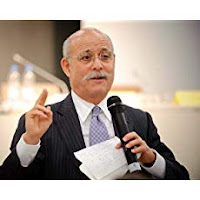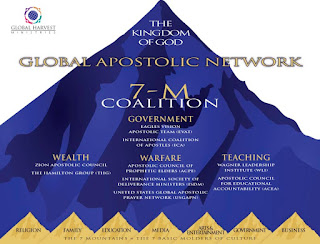Herescope Vintage Article Series
First published August 15, 2005, a few months before the Herescope blog was set up, this article* was an overview of the transformation agenda that was coming into the evangelical church world like a flood. We’ve been writing on this topic ever since. In republishing this article today we’ve embedded quite a few hyperlinks to text. Clicking on these will direct you to our subsequent articles that expanded upon these themes.
We are sad to report that over the past 14 years church transformation has come full fruit before our very eyes, and we are now witnessing the inevitable compromises and sins that are imploding ministries. The church has left its first Love, and is now losing its ability to be salt and light in the world. Any calls for revival must take an honest assessment of the issues brought forth in this article and consider a whole-hearted repentance for these errors.(Revelation 2:4-5)
 |
| Exhibit 1 |
Circa 2005:
In today’s neo-evangelical church, the term “transformation” is currently in vogue. Various churches and denominations claim to be undergoing “transformation.” This word no longer refers to the humble sanctification of the individual believer. Rather, it now refers to an orchestrated, systemic and revolutionary overhaul of the global church, including the “transformation” of cities, societies, cultures, marketplaces, and more.
We first encountered this usage of the word during the early 1990s, when “transformation” came to be associated with the massive plan to overhaul our nation’s education system. “Education transformation” was a term nuanced with esoteric meaning.—referring not only to the comprehensive “economic, social and cultural health of American society,”[1] but also, in global education circles, to education in “higher order thinking skills” to facilitate the collective evolution of consciousness.[2] We discovered that education reform gurus were using the term in the same way that the New Age Theosophists were using it.
New meanings for the word “transformation” entered the modern lexicon in the early 1980s. New Age author Marilyn Ferguson, who is credited with launching the “coming out party” for Luciferian Theosophists, extensively used the term. She defined it as “transformation of consciousness,” “a new seeing,” “conscious evolution,” and a “paradigm change.” Transformation was an essential part of the Teilhardian leap from “individual evolution” to “collective evolution.”[3] Christian discernment author Constance Cumbey bluntly remarked that Ferguson’s type of “transformation” was “a euphemism for progressively deeper levels of demonic influence.”[4]
There is currently a bait and switch going on in neo-evangelical circles. When evangelicals hear the word “transformation” bandied about, they assume it is a biblical word from Romans 12:2: “And be not conformed to this world: but be ye transformed by the renewing of your mind, that ye may prove what is that good, and acceptable, and perfect, will of God.” In fact, the traditional meaning of the word can be found in Matthew Poole’s Commentary from the 1600s, which exhorts: “Be you regenerated, and changed in your whole man; beginning at the mind, by which the Spirit of God worketh upon the inferior faculties of the soul….”[5] Matthew Henry’s Commentary further expounds, “The progress of sanctification, dying to sin more and more, and living to righteousness more and more.”[6] The Greek word for biblical “transformation” is metamorphoo, from which we get the English word metamorphosis: i.e., a complete change, such as a caterpillar turning into a butterfly. Biblical transformation, then, applies to an individual believer’s progress in sanctification.
 |
| Ed Silvoso |
When evangelicals hear the phrase “church transformation” they may think of the paradigm shift in liturgy, worship styles, music, mega-churches, etc. In reality, “transformation” is substantial and deep, intent on re-forging the very foundations of Protestantism, western civilization, and ultimately the governance of the entire earth. While lip service is being paid to the traditional definitions you read about above, in reality the word “transformation” now indicates a societal, cultural and global revolution. Here is one new definition which hints at the larger scale:
“Transformation–the measurable supernatural impact of the presence and power of God on human society, sacred and secular. In the church, this is characterized by increased holiness of life, accelerated conversion growth, reconciliation in relationships, mobilization of gifts and callings, and an increased relevance to and participation in greater society. In the culture, this may be characterized by pervasive awareness of the reality of God, a radical correction of social ills, a commensurate decrease in crime rates (evidence of authentic biblical justice, as described in Isaiah 58), supernatural blessing on local commerce, healing of the brokenhearted (the alienated and disenfranchised), and an exporting of kingdom righteousness. To this end, a catalytic core of saints typically embrace a lifestyle of persistent repentance, humility, prayer and sacrificial servanthood that attracts the favor and presence of God, and breaks the predominating influences of the ruling power structures of human flesh and the devil.”[7]
If this new definition of “transformation” sounds complex and obscure, it is. Unless you have been steeped in neo-evangelical doctrines, this will sound like mish-mash. To aid the reader, below is a nutshell synopsis of the new doctrines of “transformation.”
 |
| Jeremy Rifkin |
1) The term “transformation” is used to describe a planned, intentional “Second Reformation” (also called “New Apostolic Reformation”). An early proposal for a “second Protestant reformation” appeared in The Emerging Order (1979) by New Ager Jeremy Rifkin, who called for a re-definition of Genesis 1 to create a stewardship mandate for a dominion over the earth.[8] Rick Warren, of purpose-driven fame, positively referenced Rifkin’s proposal for this new Reformation.[9] Just this year Warren launched what he calls the “Second Reformation.”[10] Other evangelical leaders calling for this new reformation include Ralph Neighbour, Bill Hamon, Luis Bush, C. Peter Wagner, Jim Rutz, Robert Schuller, Donald Miller and many others.[11]
2) This “transformation” is not personal but is applied corporately to groups and entities. One example is: “Social transformation was defined as seeking positive change in the whole of human life materially, socially and spiritually, by recovering our true identity as human beings created in the image of God and discovering our true vocation as productive stewards, faithfully caring for our world and its people.”[12]
3) This “transformation” is to be accomplished by a “mission” strategy of doing “whatever it takes” to launch political, social, and cultural reforms on a global scale. A philosophy of “the end justifies the means” has been embraced to accomplish these colossal goals.[13]
 |
| Rick Warren |
4) Extremely sophisticated psycho-social marketing techniques are employed to facilitate this “transformation.”[14]
5) State-of-the-art statistical measurement and assessment methods evaluate this “transformation,” judging “effectiveness” by pre-set, man-made criteria.[15]
6) A plethora of intricate spiritual activities with new names, new techniques, new methodologies, and new doctrines purportedly cause “transformation” to take place in the heavenlies and then on earth.[16] These include strategic-level spiritual warfare, identificational repentance, prayer evangelism, on-site praying, spiritual mapping, prayer walks, labyrinths, spiritual formation, and a host of other newly-concocted doctrines with corresponding activities.[17] (The reader is challenged to find any of these in the Bible.)
 |
| Transformation to build the kingdom on earth |
7) A re-alignment of church hierarchical structures, not unlike network marketing, is said to be essential for “transformation” to take place.
8) These new authority and accountability structures must be superimposed between believers and God. The model is touted as a return to the early New Testament model, in which churches met in homes. In reality it is a data-driven model with a top-down hierarchy of authority and control. It is variously called cell church, G12, shepherding, House2House, etc.[18]
9) This “transformation” dialectically thrives on a diet of constant change which is accelerating rapidly.[19] Continuous change in the church is pointed to as “revival,” despite the fact that it utilizes business marketing methods such as Total Quality Management.[20]
10) The claim is made that submitting to and participating in this radical and comprehensive “transformation” is necessary to fulfill the Great Commission. Thus “transformation” has been inextricably linked to the modern missions movement.[21]
11) This “transformation” is said to be incomplete until the Bride of Christ is perfected on earth and “God’s kingdom is seen on earth as it is in heaven.”[22]
12) Therefore, believers are told they are co-creators and co-redeemers, renewing the earth through their various “transformative” activities.[23]
Neo-evangelical “transformation” doctrines integrate (or “contextualize”[24]) Theosophy with Christianity for a hybrid new orthodoxy, sometimes termed the “emergent” church. Therefore, this “transformation” is fertile ground for all new forms of ecumenism, easily finding common ground with both cults and the occult. Popular neo-evangelical leader Leonard Sweet laid out this broader concept of transformational ecumenism in his 1991 book Quantum Spirituality: A Postmodern Apologetic:
“A globalization of evangelism “in connection” with others, and a globally “in-formed” gospel, is capable of talking across the fence with Hindu, Buddhist, Sikh, Muslim–people from other so called “new” religious traditions (“new” only to us)–without assumption of superiority and power. It will take a decolonized theology for Christians to appreciate the genuineness of others’ faiths, and to see and celebrate what is good, beautiful, and true in their beliefs without any illusions that down deep we all are believers in the same thing.”[25]
Pertaining to this new-style, global-scale “transformation,” let the reader note that there is another Greek word translated as “transformed” or “transforming” into KJV English. This word is metaschematizo, which carries the root word schema which means “fashion,” from which we get the English word “scheme.” 2Cor. 11:13-15 carries this warning:
transforming themselves into the apostles of Christ.
And no marvel; f
or Satan himself is transformed into an angel of light.
Therefore it is no great thing if his ministers
also be transformed as the ministers of righteousness;
whose end shall be according to their works.”
Endnotes:
(Some of the original links no longer work. We have updated some of these endnotes with added new links and commentary. Or you can follow the hyperlinks embedded in the text of this revised article.)
1. From “Transforming American Education: Reducing the Risk to the Nation,” cited in the deliberate dumbing down of america by Charlotte Iserbyt (Conscience Press: Ravenna, Ohio, 1999), p. 233-4. http://deliberatedumbingdown.com/ddd/
2. For a thorough discussion of this point, see Kjos, Berit. Brave New Schools (Harvest House Publishers: Eugene, Oregon, 1995). http://www.crossroad.to
3. Ferguson, Marilyn. The Aquarian Conspiracy: Personal and Social Transformation in the 1980s (J.P Tarcher, Inc.: Los Angeles, 1980), p. 68-72. Note the numerous references to “transformation” in the index.
4. Cumbey, Constance. The Hidden Dangers of the Rainbow: The New Age Movement and Our Coming Age of Barbarism (Huntington House: Shreveport, Louisiana, 1983), p. 54-55. Cumbey’s book is a classic, a must-read for anyone seeking to understand the roots of the modern transformation movement in both church and society.
5. Poole, Matthew. A Commentary on the Holy Bible: Volume III: Matthew-Revelation (Hendrickson), p. 521.
6. The Matthew Henry Study Bible (World Bibles, 1994), p. 2362.
7. Authorship of this definition attributed to Tom White, who “shared his working definition of ‘transformation,’ and a conviction about the new ecclesiology of the ‘city church,’” http://boards.faithhighway.com:8080/~cityreaching/guests, Track 19 – Level 2: Advanced City Reaching, A Synopsis of the Advanced Practitioner’s Sub-Track of “Building Effective City Coalitions.” This link no longer works. Please beware that this quote was subsequently erroneously attributed to Lynn and Sarah Leslie in an act of shoddy scholarship in the book by Elbert Ransom, Jr., Let the Church Be the Church. Since 2005, the wording in this quotation can be found embedded in many evangelical church documents, including especially “Mission as Transformation – Transform World,” https://www.transform-world.net/vision-mission/ Also beware that this quotation has been reproduced, and our article appears to have been plagiarized, on page 49 of the document titled “The Wellness Revelation: An Overview,” http://www.revelationwellness.org/wp-content/uploads/2018/02/TWR-Instructors-Manual.pdf.
8. Rifkin, Jeremy with Ted Howard. The Emerging Order: God in the Age of Scarcity (G.P. Putnam’s Sons: New York, 1979), “Introduction,” pp. ix-xii. Let the reader note that the ideas put forth in this book are now being fully implemented on both the political Right and political Left as well as in the church.
9. Rick Warren’s Ministry Toolbox, Issue #60, 7/24/2002, “Christian Entrepreneurs Should Finance Kingdom Work,” by Craig R. Smith, quoting from the section of Rifkin’s book referenced above.
10. Warren’s public launching of the “Second Reformation” was done in conjunction with the Global Day of Prayer and launching his global P.E.A.C.E. Plan. See Ministry ToolBox, issue #200, 3/30/2005, “The task before us is enormous, but God is equipping us.” For in-depth documentation on this point, see articles by Sarah Leslie posted at https://www.crossroad.to/articles2/05/sarah-leslie/global-prayer.htm and https://www.crossroad.to/articles2/05/sarah-leslie/second-reformation.htm
11. Abundant documentation, too prolific to list here, can be found by simply conducting a search of these men on the Internet.
12. “World Inquiry Compendium V: City-Based Action Plans Unveiled,” headed by Luis Bush (no author cited), from the Mission Frontiers (United States Center for World Mission) website, http://www.missionfrontiers.org/2003/04/Evangelizing/Inquiry%20docs%20for%20web/PDFs/12%20of%2014%20C%20V%20%C9tion%20Plans.do.pdf, page 6 of 27, 2003
13. See article posted at http://www.discernment-ministries.org/NLJulyAugust_2005.htm for more information on this point.
14. See http://www.challies.com/archives/001166.php for one significant piece of documentation.
15. See monograph 1 in series The Pied Pipers of Purpose: Human Capital Systems and Church Performance, chapter entitled “Integrated Measurement Systems Drive Performance,” by Lynn D. Leslie, Sarah H. Leslie and Susan J. Conway. Available online at http://crossroad.to/articles2/04/pied_pipers_of_purpose.htm
16. George Otis of the Sentinel Group has produced a video series entitled “Transformation” which is widely touted by other neo-evangelical leaders as the gold standard for what this new style of “transformation” is all about. See http://www.sentinelgroup/org.
17. A partial list can be found in the “Summary Report: AD2000 United Prayer Track” report by C. Peter Wagner, archived at http://www.google.com/search?q=cache:EwPzOetQEUoJ:www.ad2000.org/re00623.htm+%22city+transformation%22%22luis+bush%22&hl=en. C. Peter Wagner is the inventor of many of the new doctrines being promulgated.
18. Contact www.discernment-ministries.org for various articles, tapes and reports pertaining to the cell church model, including conference presentations which were made by Sarah Leslie in the late 1990s.
19. Rick Joyner, a “prophet” of this “transformation,” recently wrote about an “acceleration of transformation” in an article entitled, Prepare the Way” posted at http://www.elijahlist.com/words/display_word_pf.html?ID=3306.
20. See footnote 14 above which cites Peter Drucker, management guru who mentored Rick Warren, as saying that Warren is “the inventor of perpetual revival.”
21. Various articles pertaining to this can be found at: http://gbo.faithsite.com/content.asp?CID=78746 and http://www.google.com/search?q=cache:Pe9dkmmRPJAJ:www.crossroad.to/Excerpts/world-christian-movement/transformation.htm+%22tom+white%22%22luis+bush%22transformation&hl=en
22. C. Peter Wagner, “Transform Society!” Global Prayer News, Vol. 6, No. 3, Jul-Sept 2005.
23. For examples of these new doctrines, see “The Great Commission,” by Victor Choudhrie at http://www.house2house.tv/index.pl/mag/issue6/007, or http://webgui1033.cdgcommerce.com/uploads/images/79/Issue6.pdf
page 12-15, and “Our Visions and the Ecosphere: Future Visions,” by Paul E. McKaughan of EFMA (Evangelical Fellowship of Mission Agencies) at http://efma.gospelcom.net/about/vision.php.
24. Dager, Al. The World Christian Movement (Sword Publishers: Redmond, WA), which explains the new theologies of the modern missions movement, including this doctrine of “contextualization” which essentially permits the integration of Christianity with paganism.
25. Book posted on-line at http://www.leonardsweet.com/Quantum.
Exhibit 1: This graphic illustrates the latest attempt to achieve “transformation” by orchestrating a youth movement. From ‘”The Send” marks start of ‘greatest Jesus movement’ over 40,000 Christians gather, commit to missions, Caleb Parke, Fox News, March 2, 2019, https://www.foxnews.com/faith-values/the-send-marks-start-of-greatest-jesus-movement-as-more-than-40000-christians-gather-commit-to-missions
*Copyright 2005 & 2019, Lynn and Sarah Leslie. This article was originally published at NewsWithViews: http://www.newswithviews.com/Leslie/sarah.htm. It was later posted elsewhere online, including at Mike Oppenheimer’s website here: http://www.letusreason.org/Latrain32.htm and Berit Kjos’s website here: https://www.crossroad.to/articles2/05/sarah-leslie/transformation.htm


